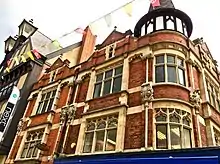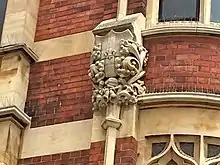William Scorer | |
|---|---|
| Born | 1843 Burwell, Lincolnshire |
| Died | 1934 Richmond, Surrey |
| Nationality | English |
| Alma mater | Articled to Henry Francis Goddard |
| Occupation | Architect |
| Practice | Watkins and Scorer. Scorer and Gamble |
William Scorer (1843–1934) was an architect who worked mainly in Lincoln, but also in Liverpool and London.[1]
Career
He was born in Burwell, Lincolnshire into a farming family. He was educated at Boston Grammar School,[2] and was a student at the Lincoln School of Art. Articled to Henry Francis Goddard of Lincoln. The 1861 Census records that he was living with the Goddards at 122, High Street, Lincoln. He worked for Culshaw and Sumners of Liverpool and then for 7 years for Edward Robert Robson, the City Surveyor for Liverpool. In 1871 Robson moved to London and Scorer appears to have accompanied him. Robson had been appointed architect to the London School Board, which was embarking on a massive school building programme. Scorer also designed some schools in his own name and gives his address as 7 Burleigh Street, Strand WC. In 1876 Scorer may have entered a short lived partnership with William Curtis Brangwyn, the father of the artist Frank Brangwyn. Brangwyn and Scorer entered the competition for Nottingham Education Institute and a print of their entry was published in the Building News.[3] The competition was won by Lockwood and Mawson and their building became the Nottingham University College and the Arkwright Building of Nottingham Trent University. Then in 1878, he entered into a partnership with William Watkins, with offices both in London and Lincoln.[4] In 1881 he was elected as an Associate of the Royal Institute of British Architects ARIBA. In 1881 he moved to Lincoln and the partnership with William Watkins, operated from St Edmond's Chambers, Lincoln. The partnership was dissolved on 31st Dec. 1883.[5] Scorer then moved to Bank Street Chambers, which was adjacent to St Swithin's Churchyard, Lincoln. From 1901 Henry Gamble joined him and formed the partnership of Scorer and Gamble. Scorer moved from Lincoln in 1913 to Richmond in Surrey, but still continued his partnership with Gamble until his death [6] After his move to Richmond, he held a position with the Royal Institute of British Architects, also until his death [7] He was a Lincoln Diocesan Surveyor and Surveyor to the Lawn Mental Institution in Lincoln. .[8][9] Scorer was an active Freemason in a number of Lodges and was the Master of the Witham Lodge in Lincoln.[1] His earlier buildings are in a Queen Anne style, while his later buildings combine Gothic Revival architecture elements. While living in London between 1874 and 1881 he was a member of the Artists Rifles, which was a Territorial Army Regiment
Architectural Work by William Scorer
- Bernadette House, Formerly St Botolph's Vicarage, South Park, Lincoln. 1877. This was designed when Scorer was practising in London.[10]
In Practice with William Watkins at St Edmond's Chambers, Silver Street.
- Lincoln Public Dispensary, Silver Street, Lincoln. with William Watkins 1878. Impressive building in Queen Anne Style, probably brick with red terracotta decoration. Advanced wing with three bays to right. First and second storeys of wing with canted bays, surmounted with a decorative pediment. This building appears to have been demolished before 1964.[11]
Practice at Bank Chambers, Bank Street, Lincoln.
Scorer moved to Bank Street in April 1884.[12]
- 102 High Street, Lincoln. (1887) Shop with living accommodation on three storeys and basement with earlier rear house, a substantial rebuild in 1887, of an earlier property. Arts and Crafts with tile hanging to third storey gable with oculus window.
- Former HSBC Bank, 25 High Street, Horncastle.(1894). Facing the Market Place. Built for the Lindsey and Lincoln Bank.[13]
- 5-6 Bank Street, Lincoln. Offices for Page and Porter, Solicitors. 1898.[14] Tudor Revival. Two storeys with two bays with three lights and additional light over decorative doorway. Brick with ashlar stringing, base coursing and dressing. Arched doorway with Tudoresque foliage and grinning faces on at ends of stringcourse above.
Scorer and Gamble
Most of the existing buildings by this practice appear to be by Gamble rather than Scorer.


- 302 High Street, Lincoln by Scorer and Gamble, 1907. In a late Tudor Gothic style with ornate carved decoration. Stylistically this appears to be the work of Scorer rather than Gamble. The south side overlooks the River Witham and has been badly disfigured by later additions which were since removed, but have scarred the building. It was originally built for a Mr J. Cooper and the southern portion was occupied by Lipton Teas. It is now occupied by Carphone Warehouse, with an unsympathetic fascia added at first-floor level.[15]
Schools
- Extension to School in Parsonage Road, Rickmansworth, Hertfordshire. (1873) Probably demolished.
- School and master's residence Croxley Green. Hertfordshire (1874)
- Classrooms and master's house, West Hyde, Hertfordshire
- Village School. Farforth, near Louth. (1887). Built for the Farforth School Board. For 42 pupils.[16]
- Extensions to Board School, Baumber, Lincolnshire (1892) [17]
- St Andrews School, Scorer Street, Lincoln (later Bishop King School) [18]
Church restoration work


- Ruckland, Lincolnshire. New Church by W. Scorer, 1885. Lincolnshire's smallest church has a rose window at the west end with a bellcote cantilevered out from the gable.[19]
- Langton, Lincolnshire1890 Church largely re-built.[20]
- Baumber, Lincolnshire. (1892). Restoration of a largely Georgian Church [21]
- Withern, Lincolnshire. Bellcote and porch by W. Scorer, 1894.[22]
- Long Bennington, Lincolnshire. 1902–03.[23]
- Doddington, Lincolnshire. Restoration by Scorer and Gamble. (1911) [24]
References
- 1 2 "William Scorer - Architect of Yorke Road School". Croxley Green History Project.
- ↑ Boston Guardian - Saturday 28 April 1900
- ↑ Building News 29th December 1876.
- ↑ Evidence from joint building applications to Lincoln City Council
- ↑ Lincolnshire Chronicle - Tuesday 08 January 1884, pg.2
- ↑ Lincoln City Building Applications register.
- ↑ Nottingham Evening Post - Thursday 25 January 1934 page 10
- ↑ "Brodie" 2001, Vol. 2, p. 554.
- ↑ Obituary The BuilderVol 146, 26 January 1934, p. 162
- ↑ Lincoln City Building Applications no.822 11/04/1877
- ↑ Lincoln City Building Applications no.967, 29/05/1878.
- ↑ Lincolnshire Chronicle - Tuesday 15 April 1884
- ↑ Lincolnshire Echo, Weds. May 23, 1894.
- ↑ Survey of Lincoln, Lincoln City Building Applications 2959, 14/04/1898
- ↑ Survey of Lincoln. Lincoln City Building Applications no 4396, 7-1907
- ↑ Stamford Mercury - Friday 15 April 1887, pg.6
- ↑ Stamford Mercury - Friday 02 September 1892 pg. 5
- ↑ Survey of Lincoln. Lincoln City Building Applications no 3213 01/11/1900
- ↑ "Antram", 1989, p. 808.
- ↑ "Antram", 1989, p. 425.
- ↑ "Antram", 1989, p. 130.
- ↑ "Antram", (1989), p. 808.
- ↑ "Antram", 1989, p. 534.
- ↑ "Antram", 1989, p. 253.
Literature
- Antram, N. (revised); Pevsner, N. & Harris, J., (1989), The Buildings of England: Lincolnshire, Penguin Books; reissued by Yale University Press.
- Brodie. A. (ed.) (2001), Directory of British Architects, 1834–1914: 2 vols. British Architectural Library, Royal Institute of British Architects.
External links
- The Survey of Lincoln: City Building Applications Database 1866–1952, for details of planning applications submitted by architects working in Lincoln.
- Croxley Green History Project “William Scorer 1843-1934 Architect of York Road School”
- William Scorer - Architect of Yorke Road School